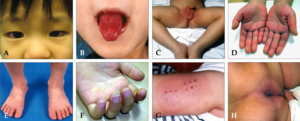We need you! Join our contributor community and become a WikEM editor through our open and transparent promotion process.
Kawasaki disease
From WikEM
(Redirected from Kawasaki Disease)
Contents
Background
- Also known as: mucocutaneous lymph node syndrome
- Vasculitis of unknown etiology
- Peaks at 18-24 months
- Rare in <4mo, >5yr
- Leading cause of acquired heart disease in children
- Coronary aneurysm more common in incomplete than in classic KD
Clinical Features
- Fever that is high, abrupt
- Rash often seen in perineum; accompanies onset of fever
- Maculopapular most common; vesicles not seen
- Cardiac complications develop early on
- Coronary artery aneurysm development most prevalent as fever lessens
Associated Symptoms
- Cardiac
- Coronary aneurysm
- Most develop during 3-4th week of illness
- May lead to MI (leading cause of death)
- Myocarditis/pericarditis
- Pericardial effusion
- LV dysnfunction
- Valvular dysfunction
- Dysrhythmias
- Coronary aneurysm
- Labs
- Elevated ESR/WBC/LFTs/Plts
- Aseptic meningitis
- Urethritis
- Anemia
- RUQ pain, large gallbladder (hydrops on US)
Differential Diagnosis
Pediatric fever
- Upper respiratory infection (URI)
- UTI
- Sepsis
- Meningitis
- Febrile seizure
- Pneumonia
- Acute otitis media
- Whooping cough
- Unclear source
- Kawasaki disease
- Neonatal HSV
Erythematous rash
- Positive Nikolsky’s sign
- Febrile
- Staphylococcal scalded skin syndrome (children)
- Toxic epidermal necrolysis (adults)
- Afebrile
- Febrile
- Negative Nikolsky’s sign
- Febrile
- Toxic shock syndrome
- Kawasaki disease
- Scarlet fever
- Afebrile
- Febrile
Evaluation
Work-Up
- CBC
- LFTs
- ESR, CRP
- Blood culture
- Urinalysis
- ECG
- TTE (Coronaries, LV, valves)
- Red Top "Kawasaki Serum to CBR"
Evaluation
- Clinical diagnosis
| Classic Kawasaki Disease | Fever for 5 days or more plus four of the following symptoms |
| 1. Bilateral nonexudative conjunctivitis | |
| 2. Mucous membrane changes (erythema, peeling, cracking of lips, "strawberry tongue," or diffuse oropharyngeal mucosae) | |
| 3. Changes of the extremities (erythema or swelling of hands/feet, peeling of finger tips/toes in the convalescent stage) | |
| 4. Rash | |
| 5. Cervical adenopathy (more than one node >1.5 cm unusually unilateral anterior cervical) | |
| Incomplete Kawasaki Disease | Fever for 5 days and two to three clinical criteria of classic Kawasaki disease plus |
| C-reactive protein 3.0 milligrams/L and/or erythrocyte sedimentation rate 40 mm/h plus positive echocardiogram or three or more of the following: | |
| 1. Albumin <3 grams/dL | |
| 2. Anemia | |
| 3. Elevated alanine aminotransferase (ALT) | |
| 4. Platelets >450,000/mm3 7d after fever onset | |
| 5. White blood cell count >12,000/mm3 | |
| 6. Pyuria |
Management
Disposition
- Admit

